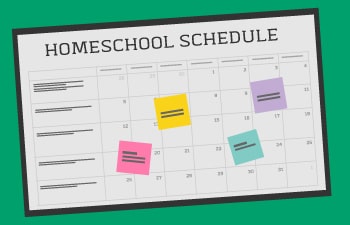If you have a student struggling with math, it can be a challenge to get them the help they need. The first step is to determine where the issue lies. Is he or she lacking foundational skills? Is it a particular concept like decimals, fractions or graphing? Once you know where the problem lies, you can better tailor the kind of supplemental material that you can use.
Whether you homeschool or your child attends traditional school, there are plenty of effective strategies for teaching students with difficulties in math. This page will explore a number of options for helping students with math in elementary, middle and high school, as well as provide information on how Time4Learning’s award-winning curriculum provides all the tools your child needs to practice and improve their math skills.
Helping Elementary School Students With Math
Play Math Games: Although there are tons of online games, many of them aren’t educational, and are free at the cost of having inappropriate ads, so be careful when choosing which games to play. One easy and safe way is Time4MathFacts, an online math fact fluency program that uses games and rewards to help students master math facts. With engaging and accessible gamified lessons, practice is a breeze!
Reinforce reading comprehension: Believe it or not, reading comprehension plays a big role in math, especially when students get into word problems. If a student doesn’t understand the question being asked, there is no way they will be able to work out the problem and provide a correct answer. Ensuring that your child has solid comprehension skills can help improve their math skills. Additionally, it’s always a good idea to have students read the question several times, and even break it down into parts for multi-step problems.
Use visual aids: This strategy can be especially helpful for visual learners and kinesthetic learners who learn by observing and doing. Posters, videos, or manipulatives like toys, candy or cereal pieces, can help bring concepts to life. In addition, having students color and draw when learning geometry and fractions can be very helpful references.
Helping Middle School Students With Math
Thorough, step-by-step instruction makes a huge difference in how well a student understands a math concept. Sometimes the key to helping students struggling with math can be as simple as teaching a topic in a different way. Whether you homeschool or just want to provide your student some after school math help, learning at home under your own terms makes a big difference.
Emphasize understanding: Building a strong middle school math foundation requires students to reinforce their elementary school math concepts and expand their understanding into more complex concepts. If your child isn’t grasping a concept, reviewing the lesson can help further their understanding, and increase their confidence. Our math curriculum for middle schoolers allows students to review material at their own pace and retake quizzes to make sure understand the concepts they learned.
For example, mastering order of operations is critical for students to thrive at higher grade levels. In chapter 2 of our 6th grade math curriculum, you’ll find activities to ensure students master this key skill before moving on to more complex concepts.
Provide and support multiple paths: “It’s not the destination, it’s the journey”. Sometimes there are multiple ways to arrive at the same answer. Whenever possible, show students the various ways they can solve a problem. Support them when they find a new path, and explore their understanding of that pathway. Challenge them to see how many different methods they can use to solve it.
Take breaks: If a concept isn’t sinking in, frustration can get the best of students. When this happens, it’s important to take a break and step back to clear one’s mind. A few minutes can make a big difference and help students tackle the material with a fresh set of eyes.
Helping High School Students With Math
Use engaging materials: Whether it’s interactive math labs like those in our high school trigonometry and pre-calculus courses, positive reinforcement, or engaging video lessons taught by funny characters, it’s important to make math fun for students of all ages.
Reinforce through practice: Students struggling with math benefit the most with this strategy. This is true at any grade level, not just high school. Once a student is finally able to grasp a difficult concept, it is important to keep at it to ensure those hard-earned skills don’t just fade away quickly. Whether it’s worksheets, flash cards, whiteboarding, or even online activities, the more a student is able to practice, the better their math skills will be.
Connect with real life applications: How many times have you heard your child say, ‘How will I use this in real life’? You can answer that question by making real-world connections which is a major feature of our high school math curriculum where teachers step into real-world settings to engage students and help apply what they are learning to the world around them.
- For example, if your child is an athlete, you can explain how knowledge of physics, geometry, and trigonometry can help improve their performance. Additionally, there are careers in sports that use math to analyze data during sporting events for a wide variety of sports.
- If your student is interested in arts and crafts, fashion design or other hands-on projects, improving math skills can help them make more accurate designs and creations.
Present students with choices: As students get older, they crave independence. Help them feel empowered by giving them the option to choose which problems to work on from a “menu” or “bank” of assignments. This can help them gain the motivation they need to improve their math skills and give them a sense of freedom and control over their studies.
Making sure students who struggle with math get the help they need is not just about improving their grades or making sure they get into a good school. Children with solid math skills become adept at the process of problem-solving. They’re able to identify the root of a problem by taking it apart and exploring possible solutions. This ultimately leads to enhanced critical thinking skills, increased confidence, and an appreciation for teamwork and effort.
Have any strategies or tips you’d like to share with other parents? Share them in the comments below!
Learn tricks and strategies to help support students struggling in math!










My child has a different problem. After mastering a procedure for solving math problems, she cannot retain the steps and then we have to start all over again in just a matter of weeks or months. Is there any way to improve her retention abilities?
Hi Billy. Thanks for stopping by, and reaching out! Time4MathFacts is an excellent way for students to build math fact fluency! The engaging gameplay and motivational rewards help to make mastering those math facts so fun for students! You can learn more here: https://www.time4mathfacts.com
You can purchase Time4MathFacts as a standalone, but Time4Learning members have access to this resource for FREE. 🙂
Please don’t hesitate to let us know if we can answer any additional questions for you! https://www.time4learning.com/curriculum/contact_us.php
Thank you so much for this article! My daughter was falling behind greatly in her math, and then I read this and now she’s completely good!
Hi Virginia, thanks for stopping by. We’re thrilled to be a valuable resource for families! 🙂